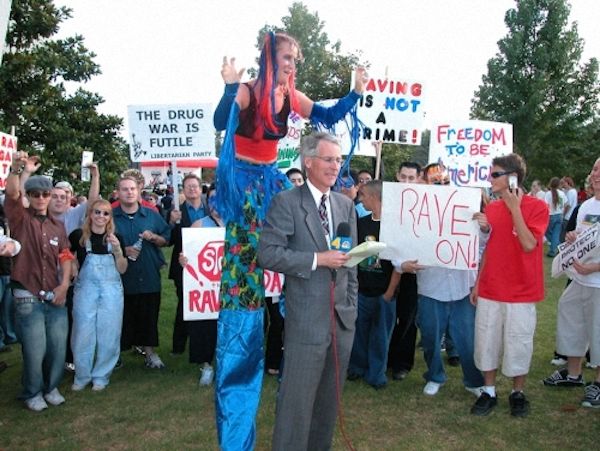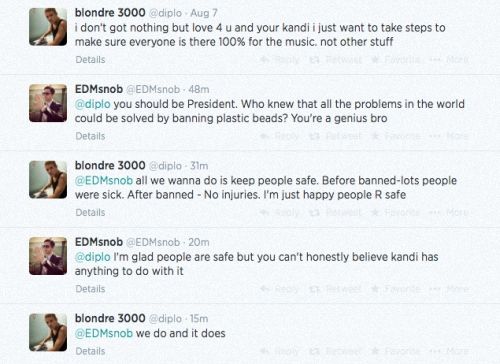
Over the weekend, an award-winning sociologist by the name of Tammy L Anderson, PhD., said everything we were all already thinking about with regards to the RAVE Act. She presented research at the annual meeting of the American Sociological Association entitled “Molly Deaths, and Why the Drug War Won’t Clean Up Rave Culture,” and it couldn’t be more correct. In case you’re not sure what I’m talking about, this will also explain why diplo recently banned “kandi” at Mad Decent parties. The short answer is, once it’s your party, you’re liable if kids do drugs at your rave.
With the deaths of party attendees on everyone’s mind, no one has mentioned the elephant in the room, and one of the primary reasons why festivals like Electric Zoo are going to such absurd measures to prevent drug at its event: The RAVE/Illicit Drug Anti-Proliferation Act of 2003 has forced most dance music promoters & producers to strip away any and all harm reduction measures (free water, extensive medical staff, etc) to escape liability if someone overdoses or dealers are found in the venue. When people started giving shit to Diplo, it showed they didn’t know anything about throwing parties. When you’re the producer, the venue, or the promoter for an EDM-based event in the USA, if any dealers are found in the venue or if a kid died, it’s on you. If anyone on your team “knowingly opens, leases, rents, or maintains, whether permanently or temporarily, any place for the purpose of using, distributing or manufacturing any controlled substance, they can be held accountable.”
This is because of a 2003 law sponsored by Joe Biden, attached as a rider to the AMBER alert system, linked to above. The important thing is that it quickly started being used to attack EDM events, and the hallmarks of rave culture became liability used against producers of those parties. They “had” to have known that the kids in the Jncos, bottles of water, and kandi, were doing/selling drugs at their party. However, if they could convince people that they didn’t know, not give them water, cater to a non-rave-feeling crowd, & make it unfriendly to drug users, then if someone OD’s in the club, the promoter technically didn’t know it was a thing, and potentially isn’t liable. Because that makes sense.

To put it bluntly, this is why the harm reduction & support system for intoxicated people at EDM events is always irregular and mediocre at best. Not because they can’t, but because if they do, they can be held responsible. I’m not kidding about this. From the paper Dr. Anderson has released:
“Researching and writing my book Rave Culture, I often witnessed this dilemma firsthand. In a techno room at a rave, I once saw a young Asian woman vomiting a white frothy liquid over and over again. When I alerted a security guard to the situation, thinking he might be able to get the woman some help, he picked her up, dragged her to the back door, and dropped her outside. Astounded by his actions, I asked the guard if he could call 911 for a medic. He told me he could not, and then told me that the club could be liable for her drug use.”
Knowing this, the refusal of harm reduction organizations to attend events like Electric Daisy Carnival, Ultra Music Festival & Electric Zoo starts to make sense. These producers simply aren’t willing to imply usage of substances at their events, even if that puts users in harm’s way. Which, according to Dr. Anderson, has created an environment that does exactly that. The lack of testing, water stations, chill out areas and adequate medical staffing is not only a cost saving measure, but actively shields producers from liability. This is the reason we don’t see DanceSafe booths at every party, and it has done way more harm than good. Dr. Anderson has studied the culture for years, stratifying event attendees, assessing behaviors and risk, seeing how the RAVE Act just didn’t work. To note, journalists declared the same problem a decade ago:
“Because the RAVE Act’s effectiveness rests on prosecutors’ proof that club owners and party promoters ‘knowingly and intentionally’ made their space available for drug use,” he wrote, “even mild harm reduction efforts could be used against the people throwing the parties.” Therefore, promoters may decide to “eliminate even the most basic safety measures, such as on-site ambulances, for fear that they could be used in court to later prove that promoters knew drugs were present.”
I’d imagine you agree with me that this makes no sense at all. And Dr. Anderson agrees with us. This chaotic environment punishes behavior that can be prevented through education, consistent messaging and encouraging producers to take care of their customers. Even the ones who make the “wrong” decisions. Organizations such as DanceSafe, the Electronic Music Alliance & others are attempting to help but the law ties the hands of anyone who produces events of even a modest size. This is a really important topic and how we handle it, collectively, will determine the future of EDM in the USA. More than 10 years ago, dance music culture was about to explode into the mainstream in the USA, then this law shattered the scene. Will this time be different?
Picture via Magnetic Mag & write-up by Medical Press, additional thanks to Daniel Fowler of the American Sociological Association.


